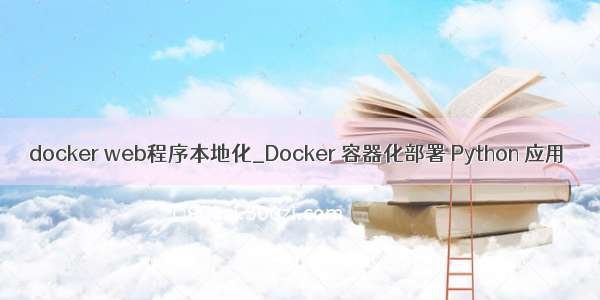
docker查看现有容器
by Daniel Newton
丹尼尔·牛顿
如何使用Docker将现有应用程序推送到容器中 (How to shove an existing application into containers with Docker)
I have finally got round to learning how to use Docker past the level of knowing what it is and does without ever using it. This is the first post that I have attempted to use Docker in and will probably be what I refer to whenever I start a new project (for Java or Kotlin anyway).
我终于回过头来学习如何在不使用Docker的情况下了解如何使用Docker。 这是我尝试使用Docker的第一篇文章,并且可能是我每次启动新项目(无论如何针对Java或Kotlin)时所指的内容。
This will be a short post that takes an existing project (from one of my other posts) and alters it so it can run inside of containers. The project is a Spring Boot application with a MongoDB database and ActiveMQ message queue. All these components are prime fodder for containerization.
这将是一篇简短的文章,它采用一个现有项目(来自我的其他文章之一)并对其进行更改,以便可以在容器内部运行。 该项目是一个带有MongoDB数据库和ActiveMQ消息队列的Spring Boot应用程序。 所有这些成分都是集装箱化的主要原料。
Completing the steps outlined in this post removes the need to have a local installation of MongoDB and ActiveMQ. Just install Docker and you’re good to go. That itself is already a victory in my books.
完成本文中概述的步骤,就无需在本地安装MongoDB和ActiveMQ。 只需安装Docker,您就可以顺利进行。 那本身已经是我书中的胜利。
Here are links to the code and the corresponding blog post. The post covers all the information about the code.
这里是代码链接和相应的博客文章 。 该帖子涵盖了有关代码的所有信息。
One last comment: for the content of this post, I am assuming that you have already installed Docker. If you haven’t, then Docker has already got you covered. Here’s where you can find the supported platforms which provide further links on how to install Docker for your specific machine. The orientation and setup page Docker provides might also be helpful.
最后的评论:对于本文的内容,我假设您已经安装了Docker。 如果您还没有,那么Docker已经为您服务。 在这里可以找到受支持的平台 ,这些平台提供了有关如何为特定计算机安装Docker的更多链接。 Docker提供的方向和设置页面也可能会有所帮助。
转换Spring App (Converting the Spring App)
First up, the Spring Boot application.
首先,是Spring Boot应用程序。
This is the only part of the project that contains our code. The rest are images downloaded from someone else’s repository. To start moving this application towards running in a container, we need to create aDockerfilethat specifies the content of an image:
这是包含我们的代码的项目的唯一部分。 其余的是从其他人的存储库下载的图像。 要开始将此应用程序移到在容器中运行,我们需要创建一个Dockerfile来指定图像的内容:
This takes the base image ofopenjdk:8-jdk-alpine. This is a good starting point for the application. It adds the Jar built from the application code (naming itapp.jar) and exposes a port for communication between containers. The final line defines the command that executed when the image is run in a container. This is what starts the Spring application.
这将获取openjdk:8-jdk-alpine的基本图像。 这是应用程序的一个很好的起点。 它添加了从应用程序代码构建的Jar(将其命名为app.jar),并公开了容器之间进行通信的端口。 最后一行定义了在容器中运行映像时执行的命令。 这就是启动Spring应用程序的原因。
To build an image from theDockerfilerun the command below (assuming you have already built the application code):
要从Dockerfile构建映像,Dockerfile运行以下命令(假定您已经构建了应用程序代码):
docker build -t spring-boot-jms-tutorial .
There is now an image namedspring-boot-jms-tutorial(-tlets us define the name). This can now be used to create a container that executes the code that is packed into the image’s Jar:
现在有一个名为spring-boot-jms-tutorial的映像(-t让我们定义名称)。 现在可以使用它来创建一个容器,该容器执行包装在图像Jar中的代码:
docker run --name application -p 4000:8080 spring-boot-jms-tutorial
This will create and run a container built from thespring-boot-jms-tutorialimage. It names the containerapplicationand the-pproperty allows a port from a local machine to be mapped to a port inside the container. To access port8080of the container we simply need to use port4000on our own machine.
这将创建并运行一个由spring-boot-jms-tutorial镜像构建的容器。 它命名了容器application,并且-p属性允许将本地计算机上的端口映射到容器内的端口。 要访问容器的端口8080,我们只需要在我们自己的计算机上使用端口4000。
If we stopped this container and wanted to run it again, we should use the command:
如果我们停止了该容器并想再次运行它,则应使用以下命令:
docker start application
Whereapplicationis the name of the container we created before. Ifdocker runwas used again it would create another new container rather than reusing the existing one. Actually, because we provided a name to the container, running the sameruncommand from earlier will lead to an error.
其中application是我们之前创建的容器的名称。 如果再次使用docker run,它将创建另一个新容器,而不是重用现有容器。 实际上,由于我们为容器提供了名称,因此从较早版本运行相同的run命令将导致错误。
Now the Spring application is successfully running in a container, but the logs are not looking very good. Let’s have a quick look so we know what we need to do next.
现在,Spring应用程序已在容器中成功运行,但是日志看起来不太好。 让我们快速浏览一下,以便我们知道下一步需要做什么。
MongoDB connection failing:
MongoDB连接失败:
Exception in monitor thread while connecting to server mongocontainer:27017 com.mongodb.MongoSocketException: mongocontainer: Name does not resolve at com.mongodb.ServerAddress.getSocketAddress(ServerAddress.java:188) ~[mongodb-driver-core-3.6.4.jar!/:na] at com.mongodb.connection.SocketStreamHelper.initialize(SocketStreamHelper.java:59) ~[mongodb-driver-core-3.6.4.jar!/:na] at com.mongodb.connection.SocketStream.open(SocketStream.java:57) ~[mongodb-driver-core-3.6.4.jar!/:na] at com.mongodb.connection.InternalStreamConnection.open(InternalStreamConnection.java:126) ~[mongodb-driver-core-3.6.4.jar!/:na] at com.mongodb.connection.DefaultServerMonitor$ServerMonitorRunnable.run(DefaultServerMonitor.java:114) ~[mongodb-driver-core-3.6.4.jar!/:na] at java.lang.Thread.run(Thread.java:748) [na:1.8.0_171] Caused by: .UnknownHostException: mongocontainer: Name does not resolve at .Inet4AddressImpl.lookupAllHostAddr(Native Method) ~[na:1.8.0_171] at .InetAddress$2.lookupAllHostAddr(InetAddress.java:928) ~[na:1.8.0_171] at .InetAddress.getAddressesFromNameService(InetAddress.java:1323) ~[na:1.8.0_171] at .InetAddress.getAllByName0(InetAddress.java:1276) ~[na:1.8.0_171] at .InetAddress.getAllByName(InetAddress.java:1192) ~[na:1.8.0_171] at .InetAddress.getAllByName(InetAddress.java:1126) ~[na:1.8.0_171] at .InetAddress.getByName(InetAddress.java:1076) ~[na:1.8.0_171] at com.mongodb.ServerAddress.getSocketAddress(ServerAddress.java:186) ~[mongodb-driver-core-3.6.4.jar!/:na] ... 5 common frames omitted
ActiveMQ also isn’t there:
ActiveMQ也不存在:
Could not refresh JMS Connection for destination 'OrderTransactionQueue' - retrying using FixedBackOff{interval=5000, currentAttempts=1, maxAttempts=unlimited}. Cause: Could not connect to broker URL: tcp://activemqcontainer:61616. Reason: .UnknownHostException: activemqcontainer
We will sort these out in the next sections so the application can work in its entirety.
我们将在下一部分中对它们进行整理,以便应用程序可以完整地工作。
One last thing before we move onto looking at Mongo and ActiveMQ.
在我们着眼于Mongo和ActiveMQ之前,还有最后一件事。
Thedockerfile-maven-plugincould also be used to help with the above which builds the container as part of runningmvn install. I chose not to use it since I couldn’t get it to work properly withdocker-compose. Below is a quick example of using the plugin:
dockerfile-maven-plugin也可以用来帮助上述工作,该工作是在运行mvn install过程中构建容器的。 我选择不使用它,因为无法使其与docker-compose一起正常工作。 以下是使用插件的快速示例:
This then allows us to replace a few of the lines in theDockerfile:
然后,这使我们可以替换Dockerfile的几行:
Here one line has been added and one existing line is changed. TheJAR_FILEargument replaces the original name of the Jar which is injected in by the plugin from thepom.xml. Make these changes and runmvn installand bam, your container is built with all the required code.
此处已添加一行,而现有一行已更改。JAR_FILE参数替换了插件从pom.xml注入的Jar的原始名称。 进行这些更改,然后运行mvn install和bam,您的容器将使用所有必需的代码构建。
使用MongoDB映像 (Using the MongoDB image)
There is a MongoDB image ready and waiting for us to use. It is ideally namedmongo… What else did you expect? All we need to do isrunthe image and give it’s container a name:
MongoDB映像已准备就绪,正在等待我们使用。 它的理想名称是mongo…您还期望什么? 我们需要做的就是run映像,并为其命名一个容器:
docker run -d --name mongocontainer mongo
Adding-dwill run the container in the background. The name of the container is not just for convenience as the Spring application will need it later to connect to Mongo.
添加-d将在后台运行容器。 容器的名称不仅是为了方便起见,因为Spring应用程序以后将需要它来连接到Mongo。
到ActiveMQ映像上 (Onto the ActiveMQ image)
Setting up ActiveMQ is just as simple as Mongo. Run the command below:
设置ActiveMQ就像Mongo一样简单。 运行以下命令:
docker run -d --name activemqcontainer -p 8161:8161 rmohr/activemq
Here the8161ports are mapped from the container to the machine it’s running on, allowing the admin console to be accessed from outside the container.
这里的8161端口是从容器映射到运行它的计算机,从而允许从容器外部访问管理控制台。
绑在一起 (Tying it all together)
If you have been running all these commands as you read through the post, you would have noticed that theapplicationcontainer hasn’t actually been able to see themongocontainerandactivemqcontainer. This is because they are not running within the same network. Getting them to communicate is not difficult and takes only a few extra steps.
如果您在阅读mongocontainer文章时一直在运行所有这些命令,则您会注意到application容器实际上还无法看到mongocontainer和activemqcontainer。 这是因为它们不在同一网络中运行。 让他们进行交流并不困难,并且只需采取一些额外的步骤。
By default, Docker creates a Bridge network when setting one up without any extra configuration. Below is how to do so:
默认情况下,Docker在进行设置时无需任何额外配置即可创建网桥网络。 以下是操作方法:
docker network create network
Now that the network (namednetwork) is created, the commands that were run previously need to be altered to create containers that will connect to the network instead. Below are the 3 commands used to create the containers in the previous sections, each altered to join the network.
现在已经创建了网络(名为network),需要更改以前运行的命令以创建将连接到网络的容器。 以下是前几节中用于创建容器的3个命令,每个命令都进行了更改以加入网络。
docker run -d --name mongocontainer --network=network mongodocker run -d --name activemqcontainer -p 8161:8161 --network=network rmohr/activemqdocker run --name application -p 4000:8080 --network=network spring-boot-jms-tutorial
Once these are all run, the application as a whole will now work. Each container can see each other. Allowing theapplicationcontainer to connect to MongoDB and ActiveMQ in their respective containers.
一旦所有这些都运行,整个应用程序现在就可以运行了。 每个容器可以看到对方。 允许application容器在各自的容器中连接到MongoDB和ActiveMQ。
At this point, everything is working. It runs in the same way that I remember it working when I had everything set up on my own laptop. But, this time around, nothing is set up locally… Except for Docker!
至此,一切正常。 它的运行方式与我记得自己在笔记本电脑上完成所有设置后就可以运行一样。 但是,这一次,本地没有任何设置……除了Docker!
Docker组成 (Docker composing it up)
We could have stopped there, but this next section will make running everything even easier. Docker Compose allows us to effectively bring all the commands that we ran earlier together and start all the containers and their network all in a single command. There is some more setup, but in the end, I think the amount of typing actually goes down.
我们可能已经在这里停了下来,但是下一节将使一切运行变得更加容易。 Docker Compose使我们可以有效地将之前运行的所有命令集中在一起,并在一个命令中启动所有容器及其网络。 还有更多设置,但最后,我认为键入的数量实际上减少了。
To do this, we need to create adocker-compose.ymlfile:
为此,我们需要创建一个docker-compose.yml文件:
Use with this version of theDockerfile:
与此版本的Dockerfile:
This is pretty much everything that needs to be done.
这几乎是需要做的所有事情。
appcontaineris the Spring application container built from the project’s code. Thebuildproperty of the container tells Docker to build the image based on the projectsDockerfilefound in the project’s root directory. It passes in theJAR_FILEargument to theDockerfilemoving some of the configurations into this file instead.
appcontainer是根据项目代码构建的Spring应用程序容器。 容器的build属性告诉Docker根据项目根目录中的项目Dockerfile构建映像。 它将JAR_FILE参数传递给Dockerfile将某些配置移入该文件。
The other two containers don’t require much setup. As with the previous commands, the images they are built from are specified andactivemqcontaineradds configuration around it’s mapped ports.
其他两个容器不需要太多设置。 与前面的命令一样,它们的生成映像已指定,activemqcontainer在其映射端口周围添加了配置。
The last piece of configuration happens in the background. A network is created and all the containers are added to it. This removes the need to create a network manually.
最后的配置发生在后台。 创建一个网络并将所有容器添加到其中。 这样就无需手动创建网络。
All that is left to do is run theupcommand:
剩下要做的就是运行up命令:
docker-compose up
This will build and run all the containers. The application code image is built if necessary. Running this exact command will output all the containers logs to the console, to do this in the background add the-dflag:
这将构建并运行所有容器。 如有必要,将构建应用程序代码映像。 运行此确切命令会将所有容器日志输出到控制台,为此在后台添加-d标志:
docker-compose up -d
After doing so, we can have a look at the created containers and network. Running:
这样做之后,我们可以查看创建的容器和网络。 运行:
docker ps -a --format "table {{.Image}}\t{{.Names}}"
Shows us:
显示给我们:
IMAGENAMESmongospring-boot-jms_mongocontainer_1spring-boot-jms_appcontainer spring-boot-jms_appcontainer_1rmohr/activemq spring-boot-jms_activemqcontainer_1
And the network:
和网络:
docker network ls
Produces:
产生:
NETWORK ID NAME DRIVER SCOPE163edcfe5adaspring-boot-jms_default bridge local
The names of the containers and network are prepended with the name of the project.
容器和网络的名称在项目名称之前。
结论 (Conclusion)
That is all there is to it…for a simple setup anyway. I’m sure there is much more the Docker gods could do but I am not one of them… Yet.
这就是全部……一个简单的设置。 我敢肯定Docker之神还可以做更多的事情,但我不是其中之一...然而。
In conclusion, we took an existing application that I wrote to work locally on a machine and shoved everything into a few containers. This meant we went from a machine that needed to have everything set up (with both MongoDB and ActiveMQ installed) to a machine that could skip all this by using containers and only requiring an installation of Docker. Docker then manages all of the dependencies for us.
最后,我们采用了一个我编写的现有应用程序,以便在计算机上本地工作,并将所有内容都放入几个容器中。 这意味着我们从一台需要设置所有内容的机器(同时安装了MongoDB和ActiveMQ)到一台可以通过使用容器而只需要安装Docker即可跳过所有操作的机器。 Docker然后为我们管理所有依赖项。
We looked at how to move each part of the application into a container and then tied it all together with Docker Compose. Leaving us, at the end of all this, with a single command that can move us from absolutely nothing to everything needed to run the application.
我们研究了如何将应用程序的每个部分移动到一个容器中,然后将它们与Docker Compose捆绑在一起。 在所有这些操作的最后,让我们离开一个命令,该命令可以使我们从绝对没有移动到运行该应用程序所需的一切。
The code used in this post can be found on my GitHub.
这篇文章中使用的代码可以在我的GitHub上找到 。
If you found this post helpful, you can follow me on Twitter at @LankyDanDev to keep up with my new posts.
如果您发现此帖子有帮助,可以在Twitter上@LankyDanDev关注我,以跟上我的新帖子。
Opinions and views found in my posts are my own and do not represent Accenture’s views on any subject. View all posts by Dan Newton
在我的帖子中发现的观点和观点是我自己的,并不代表埃森哲在任何主题上的观点。 查看丹·牛顿的所有文章
Originally published at on September 2, .
最初于9月2日发布在上。
翻译自: /news/how-to-shove-an-existing-application-into-containers-with-docker-6dcbd6152fe4/
docker查看现有容器
















